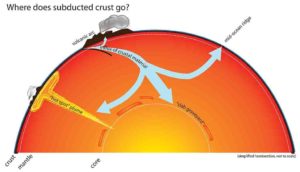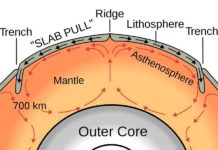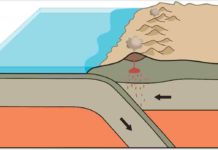
Credit: Erin Walde – Transferred from en.wikipedia to Commons., CC BY-SA 3.0
New geologic findings about the makeup of the Earth’s mantle are helping scientists better understand long-term climate stability and even how seismic waves move through the planet’s layers.
The research by a team including Case Western Reserve University scientists focused on the “deep carbon cycle,” part of the overall cycle by which carbon moves through the Earth’s various systems.
In simplest terms, the deep carbon cycle involves two steps:
- Surface carbon, mostly in the form of carbonates, is brought into the deep mantle by subducting oceanic plates at ocean trenches.
- That carbon is then returned to the atmosphere as carbon dioxide (CO2) through mantle melting and magma degassing processes at volcanoes
Scientists have long suspected that partially melted chunks of this carbon are broadly distributed throughout the Earth’s solid mantle.
What they haven’t fully understood is how far down into the mantle they might be found, or how the geologically slow movement of the material contributes to the carbon cycle at the surface, which is necessary for life itself.
Deep carbon and climate change connection
“Cycling of carbon between the surface and deep interior is critical to maintaining Earth’s climate in the habitable zone over the long term — meaning hundreds of millions of years,” said James Van Orman, a professor of geochemistry and mineral physics in the College of Arts and Sciences at Case Western Reserve and an author on the study, recently published in the Proceedings of the National Academy of Sciences.
“Right now, we have a good understanding of the surface reservoirs of carbon, but know much less about carbon storage in the deep interior, which is also critical to its cycling.”
Van Orman said this new research showed — based on experimental measurements of the acoustic properties of carbonate melts, and comparison of these results to seismological data — that a small fraction (less than one-tenth of 1%) of carbonate melt is likely to be present throughout the mantle at depths of about 180-330 km.
“Based on this inference, we can now estimate the carbon concentration in the deep upper mantle and infer that this reservoir holds a large mass of carbon, more than 10,000 times the mass of carbon in Earth’s atmosphere,” Van Orman said.
That’s important, Van Orman said, because gradual changes in the amount of carbon stored in this large reservoir, due to exchange with the atmosphere, could have a corresponding effect on CO2 in the atmosphere — and therefore, on long-term climate change.
The first author of the article is Man Xu, who did much of the work as a PhD student at Case Western Reserve and is now a postdoctoral scholar at the University of Chicago.
Others on the project were from Florida State University, the University of Chicago and Southern University of Science and Technology (SUSTech) in Shenzhen, China.
Explaining seismic wave speed differences
The research also sheds light on seismology, especially deep earth research.
One way geologists better understand the deep interior is by measuring how seismic waves generated by earthquakes — fast-moving compressional waves and slower shear waves — move through the Earth’s layers.
Scientists have long wondered why the speed difference between the two types of seismic waves — P-waves and S-waves — peaked at depths of around 180 to 330 kilometers into the Earth.
Carbon-rich melts seem to answer that question: small quantities of these melts could be dispersed throughout the deep upper mantle and would explain the speed change, as the waves move differently through the melts.
Reference:
Man Xu, Zhicheng Jing, Suraj K. Bajgain, Mainak Mookherjee, James A. Van Orman, Tony Yu, Yanbin Wang. High-pressure elastic properties of dolomite melt supporting carbonate-induced melting in deep upper mantle. Proceedings of the National Academy of Sciences, 2020; 117 (31): 18285 DOI: 10.1073/pnas.2004347117
Note: The above post is reprinted from materials provided by Case Western Reserve University.









